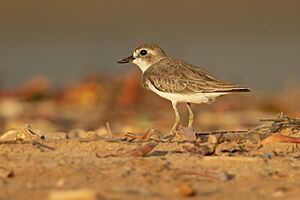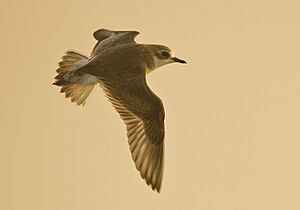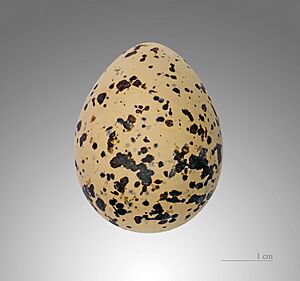Greater sand plover facts for kids
Quick facts for kids Greater sand plover |
|
|---|---|
 |
|
| Conservation status | |
| Scientific classification | |
| Synonyms | |
|
Charadrius Leschenaultii (protonym) |
The greater sand plover (Anarhynchus leschenaultii) is a small bird that lives near water. It belongs to the plover family. These birds are known as waders because they often wade in shallow water to find food. The name leschenaultii was given to honor a French botanist named Jean Baptiste Leschenault de la Tour.
Where They Live and Travel
These birds breed in dry areas, like the semi-deserts of Turkey and across Central Asia. They make their nests on the bare ground, often just a small dip called a scrape.
Greater sand plovers are migratory birds. This means they travel long distances. They spend their winters on sandy beaches in places like East Africa, South Asia, and Australia. Sometimes, they can get lost and appear in unexpected places, like western Europe or even North America. For example, one was seen in Jacksonville, Florida, in 2009.
What They Look Like
This plover is a bit chunky, with long legs and a thick bill.
- Males during breeding season have grey backs and white undersides. Their chest, forehead, and the back of their neck are a reddish-brown color. They also have a black mask around their eyes.
- Females are not as brightly colored.
- In winter or when they are young, these birds don't have the reddish-brown colors, though young birds might have a hint of it on their head.
- Their legs are greenish, and their bill is black.
The greater sand plover looks very much like its cousin, the lesser sand plover. It can be tricky to tell them apart! If you see them together on a beach, you might notice the size difference. But if you see just one bird, it's much harder to know which species it is.
What They Eat
Greater sand plovers eat mostly insects, crustaceans (like small crabs), and annelid worms. They find their food by running a bit, then pausing to look, and then running again. They don't just steadily poke around like some other wading birds.
When they fly, their call sounds like a soft trill.
Protecting These Birds
The greater sand plover is one of the birds protected by an important agreement called the Agreement on the Conservation of African-Eurasian Migratory Waterbirds (AEWA). This agreement helps protect birds that migrate across Africa and Eurasia.





